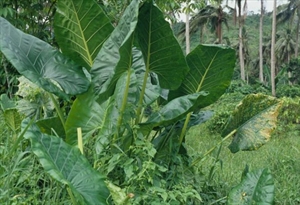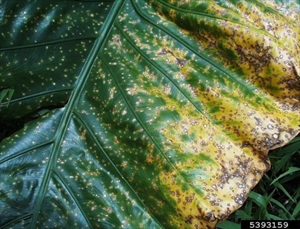Giant taro leaf spot
Pacific Pests, Pathogens, Weeds & Pesticides - Online edition
Pacific Pests, Pathogens, Weeds & Pesticides
Giant taro leaf spot (188)
Mycosphaerella alocasiae; the asexual name is Passalora colocasiae.
South and Southeast Asia, Oceania. It is recorded from American Samoa, Federated States of Micronesia, Fiji, Palau, Papua New Guinea, Samoa, Solomon Islands, Tonga, Vanuatu, and Wallis & Futuna.
Giant taro (Alocasia macrorrhizos)
Infections take place when the leaves are young, but the spots do not develop until the leaves are mature. They start as small round flecks, sunken and grey with a raised brown border, increasing up to 8 mm diameter, but much smaller when the leaf is heavily infected (Photos 1&2). Sometimes they have a yellow halo. Small black dots are present in the middle of the grey centres, especially on the upper surface of the leaves; these are the fruiting bodies containing large numbers of spores.
Spread of the spores occurs in wind-blown rain.
Only the old leaves are infected by the fungus, making it unlikely that it affects corm yield to any great extent, although leaves with severe infections die prematurely.
Look for small round spots with grey centres and brown borders on the oldest leaves. Look for black dots in the centre of the spots.
No control measures are recommended for this disease. The disease only affects older leaves, and so it is unlikely that corm yields are reduced to any great extent; the application of control measures would be uneconomic.
AUTHORS Grahame Jackson & Eric McKenzie
Information (and Photo 2) McKenzie E (2013) Mycospheaella alocasiae: PaDIL - (http://www.padil.gov.au). Photo 3 Kohler F, et al. (1997) Diseases of cultivated crops in Pacific Island countries. South Pacific Commission. Pirie Printers Pty Limited, Canberra, Australia. Photo 4 Fred Brooks, University of Hawaii, Bugwood.org.
Produced with support from the Australian Centre for International Agricultural Research under project PC/2010/090: Strengthening integrated crop management research in the Pacific Islands in support of sustainable intensification of high-value crop production, implemented by the University of Queensland and the Secretariat of the Pacific Community.







